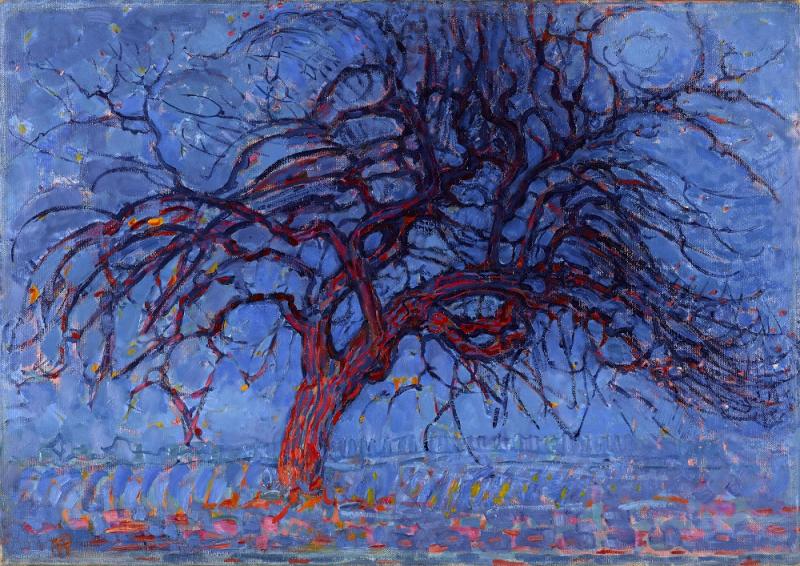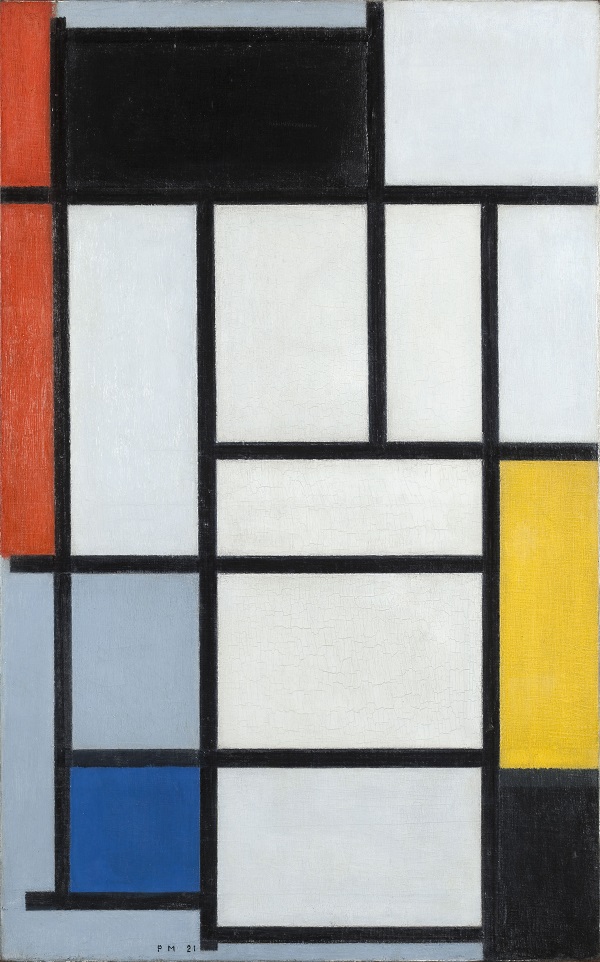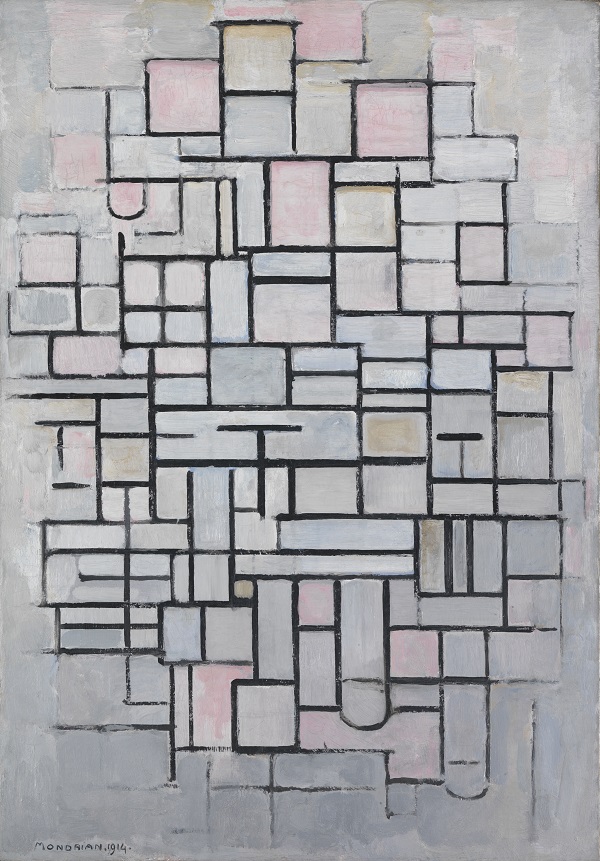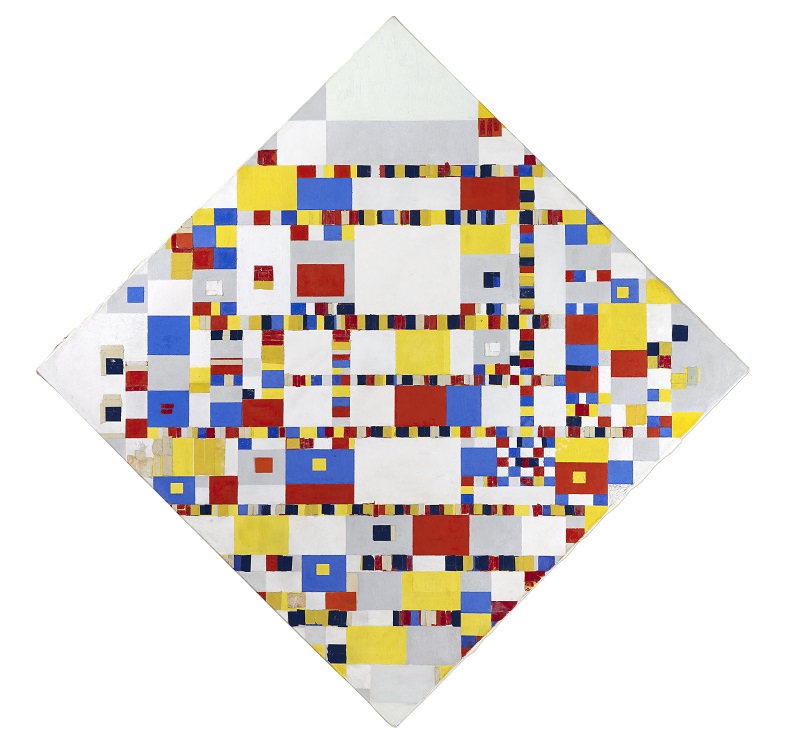The Discovery of Mondrian review - the most comprehensive survey ever | reviews, news & interviews
The Discovery of Mondrian review - the most comprehensive survey ever
The Discovery of Mondrian review - the most comprehensive survey ever
Marking 100 years of De Stijl, The Hague celebrates a local hero

Standing inside the Gemeentemuseum’s life-size reconstruction of Mondrian’s Paris studio, the painter’s reputation as an austere recluse seems well-deserved.
If the studio indicates a special sort of monomania, this exhibition, the largest and most comprehensive Mondrian retrospective ever staged, claims to move away from the image of cold obsessive. In fact, the museum’s director and co-curator of The Discovery of Mondrian Benno Tempel explains that the Paris studio was a place where, somewhat improbably, Mondrian “invited guests, transacted business and practised the steps of trendy dances like the Foxtrot, the Charleston and the Shimmy.”
 There’s no doubt that our perception of Mondrian the man is informed by the startling frigidity of geometric abstraction which, particularly when viewed in reproduction, can appear calculated and industrial, with little sense of the artist’s hand. When in 2009, the museum began a major conservation campaign, it afforded a reassessment of Mondrian’s practice, close examination of the 300 or so works in its collection revealing the extent to which he experimented and changed compositions in a manner suggestive of an intuitive and painterly painter (pictured right: Composition with red, black, yellow, blue and gray, 1921).
There’s no doubt that our perception of Mondrian the man is informed by the startling frigidity of geometric abstraction which, particularly when viewed in reproduction, can appear calculated and industrial, with little sense of the artist’s hand. When in 2009, the museum began a major conservation campaign, it afforded a reassessment of Mondrian’s practice, close examination of the 300 or so works in its collection revealing the extent to which he experimented and changed compositions in a manner suggestive of an intuitive and painterly painter (pictured right: Composition with red, black, yellow, blue and gray, 1921).
Sociable and enquiring, curious about everything modern from moving pictures to jazz, Mondrian was consistently interested in the work of other artists, and after an academic training and early adoption of the realism of the Hague School, he embraced symbolism, impressionism and pointillism. This was not slavish imitation, however, and from the start his experiments were concerned with finding an idiom with which to achieve his own already well-formed aims.
Even so, it is hard not to feel at least momentarily disappointed by his decision in 1911 to drop everything to move to Paris, having realised that his attempts at cubism, based on newspaper reports and Amsterdam gossip, were some way removed from the experiments of Picasso and Braque. Having arrived in Paris his style changed dramatically, his palette becoming muted in accordance with analytical cubism, a seemingly regressive step after his revelatory introduction of dazzling colour in 1907.
![Piet Mondrian [1872-1944] Oostzijdse Mill in the Evening, c. 1907-1908, Oil on canvas, Gemeentemuseum Den Haag Piet Mondrian [1872-1944] Oostzijdse Mill in the Evening, c. 1907-1908, Oil on canvas, Gemeentemuseum Den Haag](/sites/default/files/images/stories/ART/Florence_Hallett/Mondrian/PM_Oostzijdse%20Molen%20bij%20avond_%201907-1908small.jpg) Hyperbolic as it might sound to talk about Mondrian’s “moment of transformation”, the scope of this vast survey seems to permit just such a description, the best room of the show an apparently step-by-step guide to the artist’s conversion to colour. From the muddy browns and greens of his early landscapes (pictured above: Oostzijdse Mill in the Evening, c.1907-1908), vibrant contrasts of complementary colours make a sudden appearance in The Red Cloud, c.1907, allowing a heightened sense of an experience felt, and the revelation of apparently innate patterns and rhythms in keeping with Mondrian’s growing interest in Theosophy, a popular religious philosophy that claimed an underlying and essential order to the cosmos.
Hyperbolic as it might sound to talk about Mondrian’s “moment of transformation”, the scope of this vast survey seems to permit just such a description, the best room of the show an apparently step-by-step guide to the artist’s conversion to colour. From the muddy browns and greens of his early landscapes (pictured above: Oostzijdse Mill in the Evening, c.1907-1908), vibrant contrasts of complementary colours make a sudden appearance in The Red Cloud, c.1907, allowing a heightened sense of an experience felt, and the revelation of apparently innate patterns and rhythms in keeping with Mondrian’s growing interest in Theosophy, a popular religious philosophy that claimed an underlying and essential order to the cosmos.
Though sudden, the introduction of colour is part of a clear and logical trajectory, marking a new phase as Mondrian progressively clarifies underlying form. Where previously the muddy colours inherited from the Hague School achieved pictorial unity through a limited palette, dazzling complementary colours allowed the further intensification of form and pattern that was a consistent theme throughout his career.
 But while he conveys in paintings like Evening; The Red Tree, 1908-10 (main picture), and Mill in Sunlight, 1908, an almost hallucinatory, spiritual experience, in others, like Trees by the Gein with Moonrise, 1907, the potency of a particular motif is self-defeating, straying inexorably towards decoration. Here, and in the total abstraction of the 1920s there is the nagging sense of something lost, and in banishing the intensity of experience that characterises his work up until around 1914, perhaps he simply went too far, falling prey to what Kandinsky described as “mere geometric decoration, something like a necktie or a carpet”. One only has to note the Mondrian themed ties worn by staff at the Gemeentemuseum, to recognise that indeed, geometric abstraction presents as many problems as it solves.
But while he conveys in paintings like Evening; The Red Tree, 1908-10 (main picture), and Mill in Sunlight, 1908, an almost hallucinatory, spiritual experience, in others, like Trees by the Gein with Moonrise, 1907, the potency of a particular motif is self-defeating, straying inexorably towards decoration. Here, and in the total abstraction of the 1920s there is the nagging sense of something lost, and in banishing the intensity of experience that characterises his work up until around 1914, perhaps he simply went too far, falling prey to what Kandinsky described as “mere geometric decoration, something like a necktie or a carpet”. One only has to note the Mondrian themed ties worn by staff at the Gemeentemuseum, to recognise that indeed, geometric abstraction presents as many problems as it solves.
Marking 100 years of De Stijl, the show barely mentions the magazine and artistic movement co-founded by Mondrian with Theo van Doesburg in 1917. The inclusion of some De Stijl chairs is presumably meant to suggest the co-operation fostered between architecture, art and design but only emphasises the sense that in his move to total abstraction, Mondrian emptied his painting of the expressive capacity that would differentiate it from mere design.
Part of the trouble is that having so clearly shown earlier phases of Mondrian’s development, the crucial transition from his post-cubist experiments to the total abstraction that followed is insufficiently explored (Pictured above left: Composition No.IV, 1914). Discarding all references to observed reality, Mondrian sought to elucidate the fundamental, universal laws of existence, and yet in so doing he loses all sense of subjective experience, arriving at an art that in its reduction to colour line and plane becomes about painting itself.
 The climax of the show is ostensibly Victory Boogie-Woogie, 1942-44 (pictured right), Mondrian’s unfinished masterpiece that the Gemeentemuseum is rightfully proud of, cementing the museum’s status as the world's foremost Mondrian collection. But hung on its own, it loses any sense of its real significance; in its dynamism, inspired by the syncopated rhythms of jazz, it not only builds on the sense of movement that had been developing in his work during the 1930s, but returns, in a sense, to the previously abandoned realms of representation.
The climax of the show is ostensibly Victory Boogie-Woogie, 1942-44 (pictured right), Mondrian’s unfinished masterpiece that the Gemeentemuseum is rightfully proud of, cementing the museum’s status as the world's foremost Mondrian collection. But hung on its own, it loses any sense of its real significance; in its dynamism, inspired by the syncopated rhythms of jazz, it not only builds on the sense of movement that had been developing in his work during the 1930s, but returns, in a sense, to the previously abandoned realms of representation.
If the presentation of Victory Boogie Woogie is symptomatic of the hagiographical nature of this show, fascinating asides in the form of letters and photographs, as well as a selection of commissions go some way to offsetting this. A selection of Mondrian’s commissions are a reminder of the drudgery of the artistic life, a selection of boring portraits and copies paying the bills as he pursued his revolutionary, but not always financially rewarding vision of a new art for a world transformed.
- The Discovery of Mondrian at the Gemeentemuseum Den Hague, The Hague until 24 September 2017
- The reconstruction of Mondrian's Paris studio opens on 10 June 2017
- Read more visual arts reviews on theartsdesk
rating
Share this article
The future of Arts Journalism
You can stop theartsdesk.com closing!
We urgently need financing to survive. Our fundraising drive has thus far raised £49,000 but we need to reach £100,000 or we will be forced to close. Please contribute here: https://gofund.me/c3f6033d
And if you can forward this information to anyone who might assist, we’d be grateful.

Subscribe to theartsdesk.com
Thank you for continuing to read our work on theartsdesk.com. For unlimited access to every article in its entirety, including our archive of more than 15,000 pieces, we're asking for £5 per month or £40 per year. We feel it's a very good deal, and hope you do too.
To take a subscription now simply click here.
And if you're looking for that extra gift for a friend or family member, why not treat them to a theartsdesk.com gift subscription?
more Visual arts
 'We are bowled over!' Thank you for your messages of love and support
Much-appreciated words of commendation from readers and the cultural community
'We are bowled over!' Thank you for your messages of love and support
Much-appreciated words of commendation from readers and the cultural community
 Photo Oxford 2025 review - photography all over the town
At last, a UK festival that takes photography seriously
Photo Oxford 2025 review - photography all over the town
At last, a UK festival that takes photography seriously
![SEX MONEY RACE RELIGION [2016] by Gilbert and George. Installation shot of Gilbert & George 21ST CENTURY PICTURES Hayward Gallery](https://theartsdesk.com/sites/default/files/styles/thumbnail/public/mastimages/Gilbert%20%26%20George_%2021ST%20CENTURY%20PICTURES.%20SEX%20MONEY%20RACE%20RELIGION%20%5B2016%5D.%20Photo_%20Mark%20Blower.%20Courtesy%20of%20the%20Gilbert%20%26%20George%20and%20the%20Hayward%20Gallery._0.jpg?itok=7tVsLyR-) Gilbert & George, 21st Century Pictures, Hayward Gallery review - brash, bright and not so beautiful
The couple's coloured photomontages shout louder than ever, causing sensory overload
Gilbert & George, 21st Century Pictures, Hayward Gallery review - brash, bright and not so beautiful
The couple's coloured photomontages shout louder than ever, causing sensory overload
 Lee Miller, Tate Britain review - an extraordinary career that remains an enigma
Fashion photographer, artist or war reporter; will the real Lee Miller please step forward?
Lee Miller, Tate Britain review - an extraordinary career that remains an enigma
Fashion photographer, artist or war reporter; will the real Lee Miller please step forward?
 Kerry James Marshall: The Histories, Royal Academy review - a triumphant celebration of blackness
Room after room of glorious paintings
Kerry James Marshall: The Histories, Royal Academy review - a triumphant celebration of blackness
Room after room of glorious paintings
 Folkestone Triennial 2025 - landscape, seascape, art lovers' escape
Locally rooted festival brings home many but not all global concerns
Folkestone Triennial 2025 - landscape, seascape, art lovers' escape
Locally rooted festival brings home many but not all global concerns
 Sir Brian Clarke (1953-2025) - a personal tribute
Remembering an artist with a gift for the transcendent
Sir Brian Clarke (1953-2025) - a personal tribute
Remembering an artist with a gift for the transcendent
 Emily Kam Kngwarray, Tate Modern review - glimpses of another world
Pictures that are an affirmation of belonging
Emily Kam Kngwarray, Tate Modern review - glimpses of another world
Pictures that are an affirmation of belonging
 Kiefer / Van Gogh, Royal Academy review - a pairing of opposites
Small scale intensity meets large scale melodrama
Kiefer / Van Gogh, Royal Academy review - a pairing of opposites
Small scale intensity meets large scale melodrama
 Jenny Saville: The Anatomy of Painting, National Portrait Gallery review - a protégé losing her way
A brilliant painter in search of a worthwhile subject
Jenny Saville: The Anatomy of Painting, National Portrait Gallery review - a protégé losing her way
A brilliant painter in search of a worthwhile subject
 Abstract Erotic, Courtauld Gallery review - sculpture that is sensuous, funny and subversive
Testing the boundaries of good taste, and winning
Abstract Erotic, Courtauld Gallery review - sculpture that is sensuous, funny and subversive
Testing the boundaries of good taste, and winning
 Edward Burra, Tate Britain review - watercolour made mainstream
Social satire with a nasty bite
Edward Burra, Tate Britain review - watercolour made mainstream
Social satire with a nasty bite

Add comment